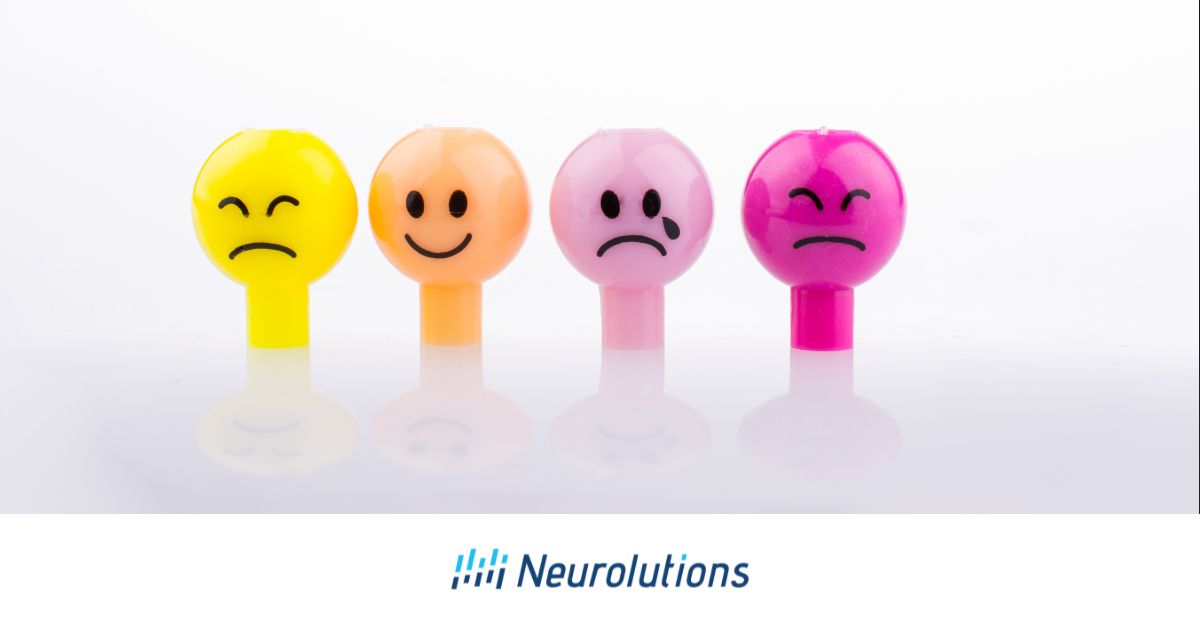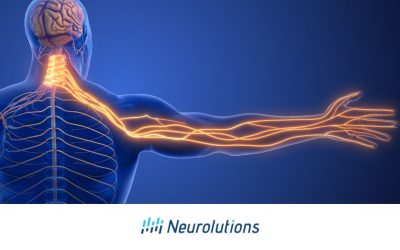What is Pseudobulbar Affect?
The Pseudobular Affect is a brain condition that causes sudden, uncontrollable laughing or crying unrelated to true feelings.
Pseudobulbar Affect (PBA) is a brain condition that causes sudden, uncontrollable episodes of laughing or crying that don’t reflect how a person actually feels. It often develops after damage to the brain pathways that regulate emotion.
This condition is common after a stroke or traumatic brain injury (TBI). It happens in at least 28% of stroke survivors.¹ PBA is even more common in people with brain disorders like Multiple Sclerosis (MS) (46%), Parkinson’s disease, or Amyotrophic Lateral Sclerosis (ALS) (49%).²,³
For care partners, it’s important to know that these emotional outbursts are not within the person’s control. These episodes can be deeply frustrating or embarrassing, but many people can learn to manage their symptoms with proper treatment.
How is Pseudobulbar Affect Different from a Mood Disorder?
Pseudobulbar Affect (PBA) is different from mood disorders like depression or bipolar disorder. In mood disorders, emotional responses match actual feelings. In PBA, damage to the brain triggers outbursts regardless of mood. Usually, people cry when they feel sad. But with PBA, changes in the brain can make a person start laughing or crying suddenly, even when it doesn’t match how they really feel.
This means a person with PBA can feel happy but still cry without being able to stop. While mood disorders are treated with therapy or medications that target emotional regulation, PBA requires treatments designed for brain injury.
PBA can sometimes be confused with conditions like Post-Traumatic Stress Disorder (PTSD). This is especially true in TBI survivors. Both conditions can involve sudden emotional outbursts, but PBA is neurological while PTSD is psychological. Since it is possible to have both conditions at the same time, accurate diagnosis is essential for treatment.⁴
People with Bipolar I Disorder may have long periods of high energy, fast talking, and little need for sleep. These episodes, called mania, can last for days. These episodes are very different from the quick, short outbursts seen in PBA.
Recognizing the Symptoms of Pseudobulbar Affect
PBA is frequently misdiagnosed as a mood disorder. This is especially true for older adults recovering from strokes or living with conditions like Alzheimer’s. However, its symptoms are distinct and include:5
- Sudden, intense episodes of laughing or crying that are uncontrollable
- Emotional outbursts that do not match the person’s actual feelings
- Facial expressions that seem inconsistent with the mood (such as smiling while crying)
How PBA Different from Post-Stroke Emotionalism:
Stroke survivors may also experience frequent emotional episodes called “post-stroke emotionalism.” While PBA and post-stroke emotionalism both involve emotional outbursts, they differ in two key ways:
- Triggers: PBA episodes are unpredictable and not tied to specific events. Post-stroke emotionalism typically happens after emotional triggers, such as seeing a photo or recalling a memory.
- Treatment: Post-stroke emotionalism can often improve with treatments like counseling, cognitive therapy, and rehab programs. Doctors usually diagnose this using a tool called the Testing Emotionalism After Recent Stroke Questionnaire (TEARS-Q).6 PBA, however, requires a different treatment plan that is designed for brain injuries.
Causes of Pseudobulbar Affect
Brain damage and chemical changes cause sudden emotional outbursts.
What Causes Pseudobulbar Affect?
PBA occurs when brain pathways that control emotions are damaged. One of the most important connections is between the prefrontal lobe and the cerebellum. When this connection is harmed, it affects the brain’s ability to release certain chemicals, called neurotransmitters, which help control mood and emotions.7, 8
https://neurotorium.org/image/brain-circuitry-and-emotional-lability/
These chemicals include:9
- Dopamine: helps create feelings of pleasure and reward. Low levels can make it harder to feel enjoyment.
- Serotonin: helps stabilize mood and supports feelings of happiness. A lack of serotonin can lead to ongoing depression.
- Norepinephrine: affects focus, memory, and the body’s response to stress. When levels are off, it can cause anxiety or tiredness.
- Glutamate: plays a role in sleep, relaxation, and emotional balance. Low levels are linked to depression and mood changes.
How is Pseudobulbar Affect Diagnosed?
Doctors use medical history, physical exams, and rating scales to properly diagnose PBA and rule out other conditions.
If a person is suspected of having PBA, the diagnosis often begins with the person’s primary care physician (PCP). The PCP will review their medical history and symptoms and may refer the individual to a neurologist.
These are steps a PCP will take to diagnose PBA:
- Medical History and Symptom Review: A detailed review of symptoms helps the doctor understand the frequency, triggers and nature of emotional outbursts.
- Physical and Neurological Exams: A neurologist may do a thorough examination to check how well the brain and nerves are working.
- Brain Imaging: Tests like MRIs or CT scans may be used to look for damage in areas of the brain linked to emotional regulation.
- Symptom Rating Scales: To confirm the diagnosis and rule out other causes, patients may complete questionnaires.10, 11
The Impact of Pseudobulbar Affect on Everyday Life
This condition can lead to social isolation, depression, and lower quality of life.
Living with PBA can significantly affect daily life. Episodes of uncontrollable laughing or crying can cause embarrassment and lead many people to withdraw from social activities. Over time, this isolation can lead to loneliness and depression.
The emotional stress of PBA can also lead to chronic mental health issues. Studies show that 30-35% of people with PBA develop chronic depression.12 Additionally, 17% develop a major anxiety disorder.13 This combination of emotional strain, social isolation, loneliness, and reduced motivation can negatively affect both mental health and overall quality of life.
Coping Strategies to Improve Mental Health
Coping strategies can ease the impact of episodes and reduce anxiety.
Managing PBA involves open communication and practical strategies to foster understanding and reduce anxiety about episodes. Additionally, mental health counseling can provide support for managing the emotional challenges of living with PBA.
During episodes, the following techniques may be helpful:14
- Find distractions, like focusing on a picture on the wall
- Take slow, deep breaths to help calm the body
- Relax the body, particularly the muscles that tend to tense during laughter or crying
- Change physical positions or ask for assistance in repositioning for comfort
Treatments for Pseudobulbar Affect
Treatment options include medication, lifestyle changes, and coping strategies.
Treatment for PBA combines FDA-approved medications with behavioral strategies to help manage episodes and improve quality of life.
The only FDA-approved medication for PBA is a combination of dextromethorphan and quinidine. While this medication was originally introduced for use in people with MS or ALS, it has been used for stroke and TBI survivors and others diagnosed with PBA.15
However, this medication is not suitable for everyone. It cannot be taken by individuals with certain conditions like heart rhythm disorders or myasthenia gravis. In addition, this prescription drug cannot be used by people taking another medication containing quinidine, or certain antidepressants classified as Monoamine Oxidase Inhibitors (MAOI).
For some people, antidepressants like Selective Serotonin Reuptake Inhibitors (SSRIs) or Tricyclic Antidepressants (TCAs) are prescribed. These antidepressants are typically prescribed at lower doses than those used for treating depression.16 These antidepressants can help manage PBA-associated depression, improving overall mood and quality of life.17
Behavioral Management for Pseudobulbar Affect:
Activities and lifestyle changes may help reduce episodes and support mental health.
Behavioral strategies can complement medication and help manage PBA episodes. Techniques such as deep breathing and slow-motion exercises during an episode may provide relief. Regular social activities can boost mood and help reduce PBA’s emotional burden. For stroke and TBI survivors, managing chronic depression is essential for maintaining cognitive abilities and overall health.
While behavioral approaches may not cure PBA, they can shorten the duration of an episode. This can enhance the quality of life for those living with the condition.18
Tips for Caregivers of a Person with Pseudobulbar Affect
Caregivers can provide crucial support by being patient, understanding, and helping educate others about PBA.
Caring for a person with PBA can be challenging. Sudden episodes of laughing or crying that cannot be controlled may feel confusing or frustrating. However, these episodes are even more embarrassing and difficult for the person living with PBA. Here are five tips to support both the individual with PBA and as their care partner:19
- Be a compassionate listener: When an episode occurs, listen without judgment and offer reassurance that the outburst is not upsetting.
- Stay patient: Avoid reacting with anger or frustration, as the episodes are involuntary. Demonstrating patience and understanding can help the person feel more supported.
- Acknowledge the condition: Remind the individual that PBA is a neurological disorder caused by brain changes, not a psychological problem. This acknowledgment can help reduce feelings of shame.
- Offer support at appointments: When possible, accompany the person to appointments, such as medical visits or haircuts, to help explain symptoms and reduce social discomfort.
- Educate others: Promote understanding by informing friends, family, and community members about PBA. Increased awareness can help reduce stigma and foster social inclusion.
Conclusion
With the right care, people with PBA can manage symptoms and live well.
Pseudobulbar Affect (PBA) is caused by damage to the cerebellum or its brain pathways and results in episodes of laughing or crying that cannot be controlled. PBA is common in stroke and Traumatic Brain Injury (TBI) survivors, as well as those with neurodegenerative disorders such as Multiple Sclerosis (MS), and Parkinson’s disease.19 PBA is often misdiagnosed as a psychological condition.
Treatment options include FDA-approved medication, certain types of antidepressants, and behavioral techniques like relaxation and distraction. Without proper support, PBA can lead to social isolation, loneliness and depression. Care partners, family members, and friends play a crucial role by offering patience, understanding, and reassurance. This helps to reduce stigma and support the person’s emotional and social health.
With proper diagnosis, treatment, and support from care partners, people with PBA can manage their symptoms and maintain their quality of life.
8090.926.E
©2025 Kandu, Inc. All Rights Reserved.
References:
- Lapchak PA. (2015). Neuronal Dysregulation in Stroke-Associated Pseudobulbar Affect (PBA): Diagnostic Scales and Current Treatment Options. Journal of Neurology and Neurophysiology 6(5): 323. Webpage: https://pmc.ncbi.nlm.nih.gov/articles/PMC4675467/#:~:text=PBA%20is%20a%20behavioral%20syndrome,events%2C%20and%20higher%20in%20females
- Vidović V, Rovazdi MČ, Kraml O, et al. (2015). Pseudobulbar Affect in Multiple Sclerosis Patients. Acta Clin Croat 54(2): 159-163. PMID: 26415311. Webpage: https://pubmed.ncbi.nlm.nih.gov/26415311/
- Schiffer R, and Pope LE. (2005). Review of Pseudobulbar Affect Including a Novel and Potential Therapy. The Journal of Neuropsychiatry and Clinical Neurosciences 17(4): 447-454. Webpage: https://psychiatryonline.org/doi/10.1176/jnp.17.4.447
- Engelman W, Hammond FM, and Malec JF. (2014). Diagnosing pseudobulbar affect in traumatic brain injury. Neuropsychiatric Disease and Treatment 10: 1903-1910. Webpage: https://pmc.ncbi.nlm.nih.gov/articles/PMC4200065/
- Ahmed A, and Simmons Z. (2013). Pseudobulbar affect: Prevalence and management. Therapeutics and Clinical Risk Management 9: 483-489. Webpage: https://pmc.ncbi.nlm.nih.gov/articles/PMC3849173/10
- Broomfield NM, Blake J, Gracey F, et al. (2024). Post-stroke emotionalism: Diagnosis, pathophysiology, and treatment. International Journal of Stroke 19(8): 857-866. Webpage: https://journals.sagepub.com/doi/epdf/10.1177/17474930241242952?src=getftr&utm_source=wiley&getft_integrator=wiley
- Frazier MR, Hoffman LJ, Popal H, et al. (2022). A missing link in affect regulation: The cerebellum. Social Cognitive and Affective Neuroscience 17(12): 1068-1081. Webpage: https://pmc.ncbi.nlm.nih.gov/articles/PMC9714429/
- Demler TL. (2017). Introduction to Pseudobulbar Affect: Setting the Stage for Recognition and Familiarity With This Challenging Disorder. American Journal of Managed Care 23(18): S339-S344. Webpage: https://www.ajmc.com/view/introduction-to-pseudobulbar-affect-setting-the-stage-for-recognition-and-familiarity-with-this-challenging-disorder
- Cleveland Clinic [Cleveland, OH]. Pseudobulbar Affect (PBA). Webpage: https://my.clevelandclinic.org/health/diseases/17928-pseudobulbar-affect-pba
- Woodard TJ. (2017). Review of the Diagnosis and Management of Pseudobulbar Affect. U.S. Pharmacist 42(11): 31-35. Webpage: https://www.uspharmacist.com/article/review-of-the-diagnosis-and-management-of-pseudobulbar-affect
- Rudolph JL, Fonda JR, Hunt PR, et al. (2016). Association of Pseudobulbar Affect symptoms with quality of life and healthcare costs in Veterans with traumatic brain injury. Journal of Affective Disorders 190: 150-155. Webpage: https://www.sciencedirect.com/science/article/pii/S0165032715304560
- Mayo Clinic. Pseudobulbar affect. Webpage: https://www.mayoclinic.org/diseases-conditions/pseudobulbar-affect/diagnosis-treatment/drc-20353741
- Cruz MP. (2013). Nuedexta for the treatment of pseudobulbar affect: A condition of involuntary crying or laughing. Pharmacy and Therapeutics 38(6): 325-328. Webpage: https://pmc.ncbi.nlm.nih.gov/articles/PMC3737988/
- Chen JJ. (2017). Pharmacotherapeutic Management of Pseudobulbar Affect. American Journal of Managed Care American Journal of Managed Care 23(18): S345-S350. Webpage: https://www.ajmc.com/view/pharmacotherapeutic-management-of-pseudobulbar-affect
- Patel N, Combs H, York M, et al. (2018). Pseudobulbar Affect Correlates With Mood Symptoms in Parkinsonian Disorders but Not Amyotrophic Lateral Sclerosis. The Journal of Neuropsychiatry 30(3): 214-219. Webpage: https://psychiatryonline.org/doi/10.1176/appi.neuropsych.17070131
- Turell W, Roc A, Pioro E, et al. (2020). Living With the Burden of Pseudobulbar Affect: A Qualitative Analysis of the Effects of Education on Patient Experience. Journal of Patient Experience 7(6): 1324-1330. Webpage: https://journals.sagepub.com/doi/full/10.1177/2374373519899597
- PBA Voices [PseudoBulbar Affect Voices]. Resources for Caregivers. Webpage: https://pbavoices.org/resources/caregivers/
- Cruz MP. (2013). Nuedexta for the treatment of pseudobulbar affect: A condition of involuntary crying or laughing. Pharmacy and Therapeutics 38(6): 325-328. Webpage: https://pmc.ncbi.nlm.nih.gov/articles/PMC3737988/
- Hakimi M, and Maurer CW. (2019). Pseudobulbar Affect in Parkinsonian Disorders: A Review. Journal of Movement Disorders 12(1): 14-21. Webpage: https://www.e-jmd.org/journal/view.php?doi=10.14802/jmd.18051
Kekere V, Qureshi D, Thanju A, et al. (2022). Pseudobulbar Affect Mimicking Depression: A Case Report. Cureus 14(6): e26235. Webpage: https://pmc.ncbi.nlm.nih.gov/articles/PMC9312808/





